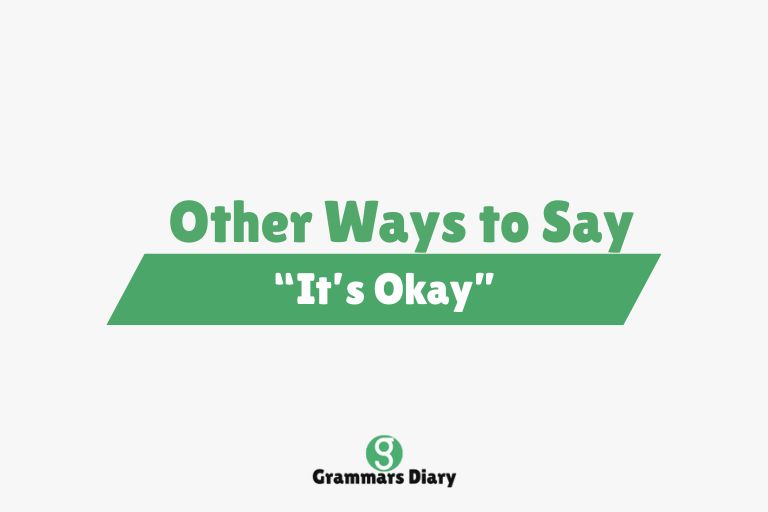“It’s okay” is a phrase we hear and use every day, whether we’re comforting someone, accepting an apology, or expressing that something doesn’t bother us. It carries a sense of acceptance, reassurance, and emotional balance. For instance, when someone says, “It’s okay, don’t worry about it,” they’re offering a gesture of emotional support and letting the other person know that the situation isn’t as bad as it seems.
However, English offers many other expressions that can be used to convey the same idea, often with slightly different tones, emotional depths, or contexts. Some alternatives sound more formal, others are more casual, and some may add a touch of empathy, forgiveness, or even indifference, depending on what you want to express.
This blog post explores 25 different ways to say “it’s okay,” offering meanings, examples, and usage tips to help you expand your vocabulary and express yourself with more nuance and clarity.
Other Ways to Say “It’s Okay”
1. No problem
Example: “No problem, I totally understand why you were late.”
Meaning: Used to say that something is not an issue or doesn’t bother you. It’s a way to quickly forgive or dismiss a mistake or inconvenience.
Usage: Very common in casual settings, especially when responding to minor mistakes or when someone says thank you.
2. Don’t worry about it
Example: “Don’t worry about it, everything turned out fine.”
Meaning: A phrase meant to ease someone’s guilt, anxiety, or stress about a situation, implying that there’s no lasting harm or concern.
Usage: Suitable for comforting someone or downplaying a concern.
3. That’s all right
Example: “That’s all right, everyone makes mistakes.”
Meaning: A calm, forgiving response that communicates tolerance and understanding, without placing blame.
Usage: Often used in both casual and slightly formal settings to accept an apology or acknowledge a small error.
4. No worries
Example: “No worries, I’ve got everything under control.”
Meaning: A relaxed, informal way of saying there’s no need for concern, stress, or apology.
Usage: Widely used in Australian and British English, and increasingly popular in American English.
5. It’s all good
Example: “It’s all good, really—no hard feelings.”
Meaning: A friendly way to show that everything is fine, and no negativity is being held onto.
Usage: Casual, often used in friendly or familiar interactions.
6. That’s fine
Example: “That’s fine, we can reschedule for tomorrow.”
Meaning: A neutral phrase indicating acceptance of a situation or proposal without enthusiasm or annoyance.
Usage: Polite and versatile; works in both casual and semi-formal scenarios.
7. Not a big deal
Example: “It’s not a big deal, just a small delay.”
Meaning: A phrase that minimizes the importance of an issue or mistake, signaling that it’s not worth getting upset about.
Usage: Good for diffusing tension or calming someone who’s worried about a minor mishap.
8. That’s understandable
Example: “That’s understandable, given how busy you’ve been lately.”
Meaning: A thoughtful phrase that shows empathy by acknowledging someone’s circumstances or behavior as reasonable.
Usage: Ideal for showing maturity and compassion in emotionally sensitive contexts.
9. All right then
Example: “All right then, we’ll go with your suggestion.”
Meaning: A casual phrase indicating acceptance or agreement, often signaling the end of a discussion.
Usage: Used to move things forward or agree to a plan without further debate.
10. I’m okay with that
Example: “I’m okay with that change in schedule.”
Meaning: A direct way to show consent or comfort with a decision or situation.
Usage: Appropriate in both personal and professional discussions.
11. Fair enough
Example: “Fair enough, I see your point.”
Meaning: A phrase that acknowledges someone’s reasoning as valid, even if you may not fully agree.
Usage: Popular in British English, suitable for calm and open-minded conversations.
12. That’s acceptable
Example: “Your explanation is acceptable given the circumstances.”
Meaning: A formal or professional phrase used to convey agreement or tolerance for something that meets minimum standards.
Usage: Best used in formal emails or workplace discussions.
13. I understand
Example: “I understand why you had to cancel last minute.”
Meaning: A phrase that shows emotional or intellectual comprehension of another person’s situation.
Usage: Supportive and empathetic, often used to build rapport or resolve conflict.
14. I forgive you
Example: “I forgive you—it was a tough time for both of us.”
Meaning: A heartfelt phrase that releases resentment or blame, especially in deeper emotional situations.
Usage: Used in more serious contexts where emotional healing is involved.
15. No harm done
Example: “No harm done—we caught the mistake early.”
Meaning: A phrase used to indicate that even though something may have gone wrong, no real damage or negative consequence occurred.
Usage: Reassuring and casual, often used to put someone at ease after a mistake.
16. It happens
Example: “It happens—don’t be too hard on yourself.”
Meaning: A phrase used to normalize mistakes or accidents by recognizing that they’re part of life.
Usage: Empathetic and supportive, perfect for offering emotional comfort.
17. Never mind
Example: “Never mind, we’ll figure it out later.”
Meaning: A quick way to dismiss a concern or forget about something that no longer matters.
Usage: Often used to change the subject or stop someone from dwelling on an issue.
18. You’re good
Example: “You’re good, no need to explain.”
Meaning: An informal phrase that reassures someone that everything is fine and they don’t need to worry.
Usage: Friendly and relaxed, commonly used in casual conversations.
19. It’s nothing
Example: “It’s nothing—I didn’t even notice.”
Meaning: Used to downplay a favor, mistake, or issue as insignificant or unworthy of concern.
Usage: Very casual, often used to make someone feel at ease.
20. It’s no trouble
Example: “It’s no trouble at all, I was happy to help.”
Meaning: A polite and gracious way to show that doing something for someone didn’t inconvenience you.
Usage: Useful in service or favor-related conversations, both casual and semi-formal.
21. Everything’s fine
Example: “Everything’s fine, we’ve got it covered.”
Meaning: A calm and direct reassurance that there’s nothing wrong or concerning.
Usage: Suitable for diffusing tension or maintaining composure in uncertain situations.
22. We’re good
Example: “We’re good—no need to go over it again.”
Meaning: A friendly way to say that there’s no conflict or unresolved issue between people.
Usage: Informal and conversational, often used in relationships or among friends.
23. Chill, it’s cool
Example: “Chill, it’s cool—you didn’t ruin anything.”
Meaning: A relaxed phrase encouraging someone to calm down and not take things too seriously.
Usage: Very informal, often used among younger speakers or in laid-back settings.
24. Let it go
Example: “Just let it go—it’s not worth getting upset about.”
Meaning: A phrase suggesting someone should move past an issue or emotion and not dwell on it.
Usage: Encouraging and supportive, often used when someone is overly self-critical.
25. It’s not the end of the world
Example: “It’s not the end of the world—we can fix it tomorrow.”
Meaning: A comforting way to put a mistake or problem into perspective, showing that it’s not catastrophic.
Usage: Supportive and perspective-giving, useful when calming someone’s anxiety or stress.
When to Use Different “It’s Okay” Alternatives
In Supportive Conversations
When someone is upset, anxious, or feeling guilty, phrases like “Don’t worry about it,” “I understand,” or “It happens” can help ease tension, demonstrate empathy, and offer a reassuring emotional tone that builds trust and connection.
In Apology Situations
If you’re on the receiving end of an apology, more affirming phrases like “I forgive you,” “That’s all right,” or “No harm done” convey acceptance and kindness without holding a grudge, which helps maintain healthy personal or professional relationships.
In Casual or Friendly Settings
In everyday conversations with friends, classmates, or coworkers, casual phrases like “No worries,” “You’re good,” or “It’s all good” make communication relaxed and friendly while letting others know you’re not upset.
Conclusion
The phrase “It’s okay” is one of the most versatile and emotionally rich expressions in the English language, used to reassure, forgive, accept, or calm others. However, as language learners and communicators, it’s helpful to expand our vocabulary to include a wider range of expressions that can reflect different emotional tones, degrees of formality, and personal style. Whether you’re comforting a friend, resolving a conflict, or simply acknowledging an error, choosing the right alternative can make your communication more authentic and effective.
If you’re looking to improve your vocabulary or learn more nuanced ways to express yourself, consider exploring resources like Thesaurus.com or real-life conversation examples to see how these expressions are used in different contexts.
FAQs
What does “It’s okay” mean?
“It’s okay” is an expression that generally means something is acceptable, forgiven, or not a problem. It can also be used to comfort someone or to show agreement in a relaxed way.
Is “It’s okay” formal or informal?
“It’s okay” is typically informal but can be used in a variety of situations. In more formal settings, alternatives like “That’s acceptable” or “No problem” may be more appropriate.
Can “It’s okay” mean both forgiveness and indifference?
Yes, the phrase can be used to express both forgiveness (e.g., accepting an apology) and indifference (e.g., not minding a small mistake), depending on tone and context.











